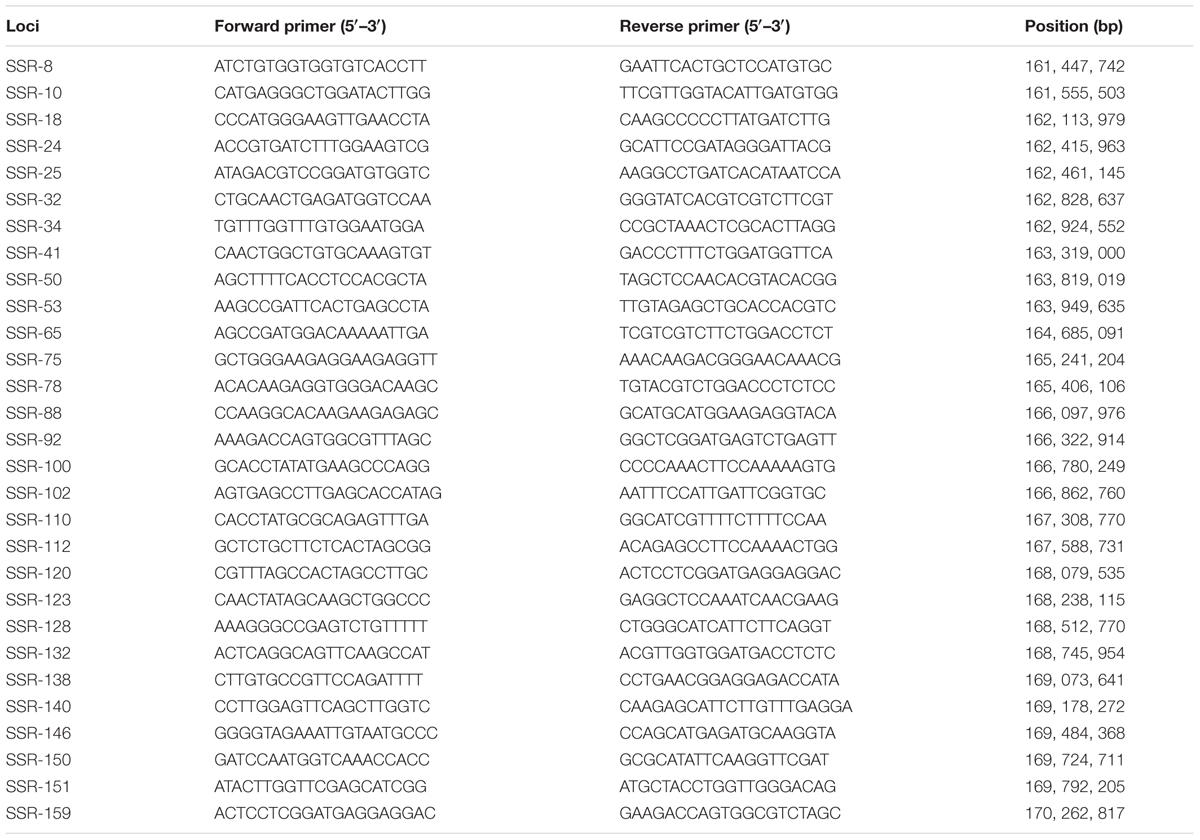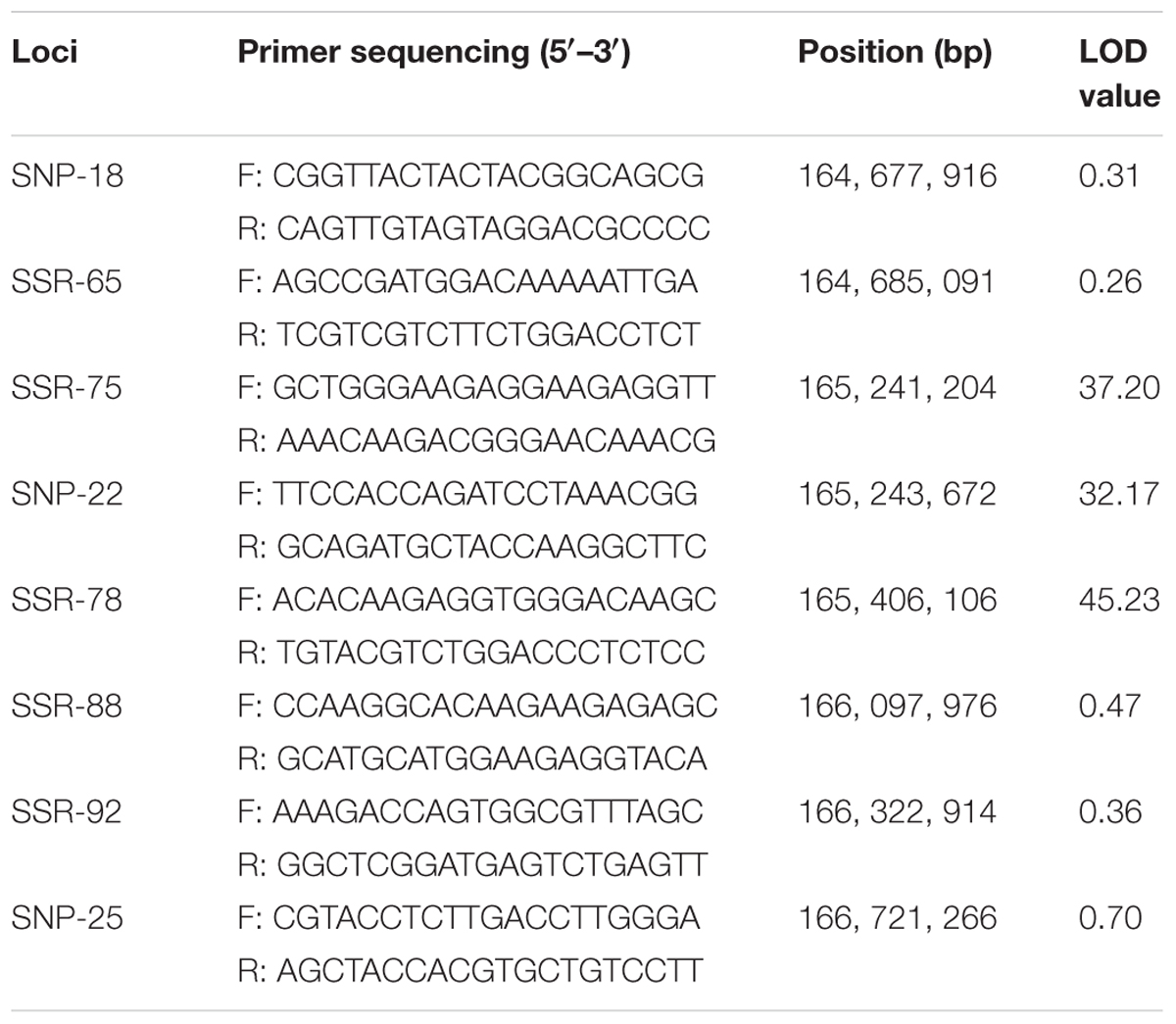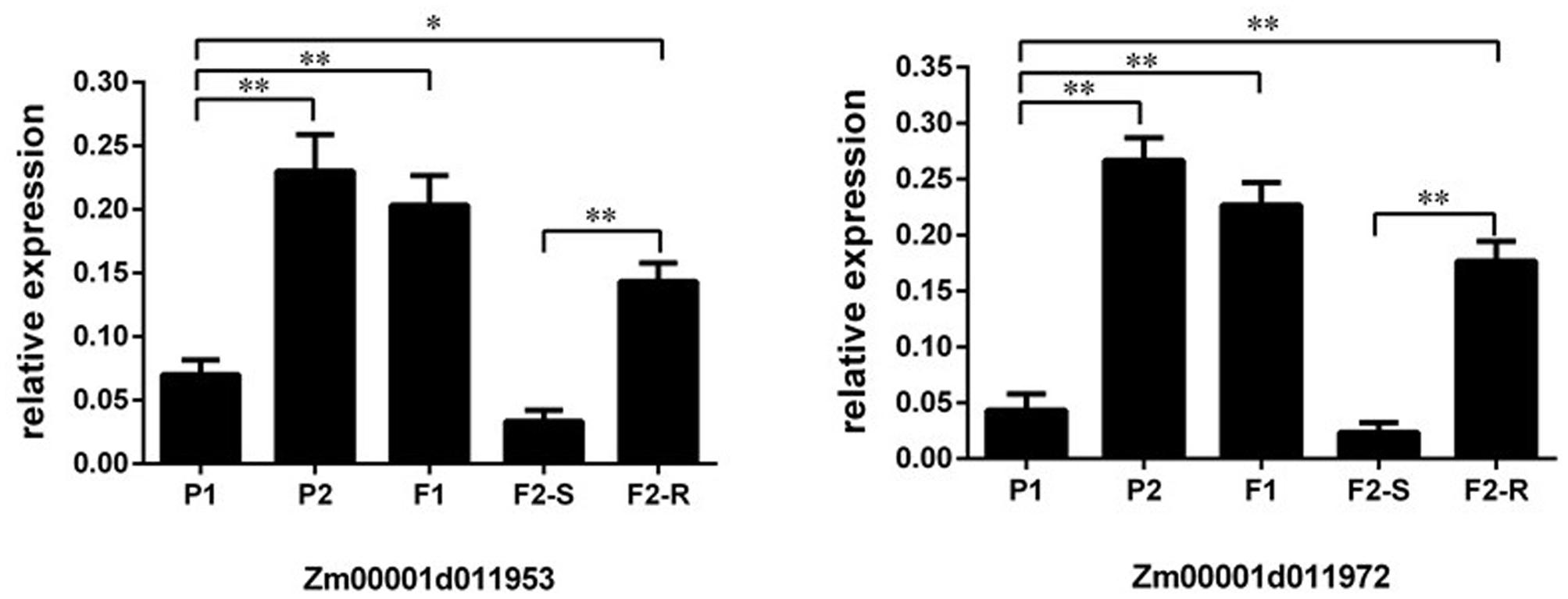- Institute of Biotechnology and Nuclear Technology, Sichuan Academy of Agricultural Sciences, Chengdu, China
Maize stalk rot is a major fungal disease worldwide, and is difficult to control by chemical methods. Therefore, in maize breeding, quantitative trait loci (QTLs) conferring resistance are important for controlling the disease. Next-generation sequencing technologies are considered a rapid and efficient method to establish the association of agronomic traits with molecular markers or candidate genes. In the present study, we employed QTL-seq, which is a whole-genome resequencing-based approach, to identify candidate genomic regions conferring resistance to maize stalk rot. A novel resistance QTL Rgsr8.1 was finely mapped, conferring broad-spectrum resistance to Gibberella stalk rot (GSR). Segregation analysis in F2 and BC1F1 populations, which were derived from a cross between 18327 (Susceptible) and S72356 (Resistant), indicated that the resistance to GSR was likely to be a quantitatively inherited trait in maize. The result of QTL-seq showed that the resistance to GSR was mapped on chromosome 8 from 161.001 to 170.6 Mb. Based on the simple sequence repeat (SSR) markers, single-nucleotide polymorphism (SNP) markers, and the recombinant test, the location of Rgsr8.1 was narrowed down to 2.04 Mb, flanked by SSR-65 and SNP-25 markers at the physical location from 164.69 to 166.72 Mb based on the maize reference genome. In this region, two candidate resistant genes were found with, one auxin-responsive elements and the other encoding a disease resistance protein. In summary, these results will be useful in maize breeding programs to improve the resistance to GSR in maize.
Introduction
As one of the most devastating soil-borne diseases in maize (Zea mays L.), maize stalk rot occurs in all continents of the world (Francis and Burgess, 1975; Lal and Singh, 1984; Chambers, 1988; Ledencan et al., 2003; Cook, 2008). Maize stalk rot was firstly detected in China in the 1920s (Yang et al., 2002a), and has recently become a major threat to maize production. Furthermore, maize stalk rot also causes plant lodging and other issues, including yield reduction, low grain quality, and problems during harvest (Ledencan et al., 2003). White (1999) indicated that both fungal and bacterial pathogens can cause stalk rot in maize. Fusarium graminearum Schwabe (teleomorph Gibberella zeae) is one of the major stalk rot pathogens, causing Gibberella stalk rot (GSR) in maize, producing a wide variety of mycotoxins during pathogen invasion (Wu et al., 2007). Because of the soil-borne infection pathway, fungicides are ineffective in controlling GSR. Hence, the use of resistance gene(s) has been demonstrated to be both economical and the most effective method in controlling GSR (Yang et al., 2004, 2005, 2010).
Previous studies indicated that resistance to GSR was controlled by qualitative and quantitative genetic loci. Based on F2:3 families, deriving from the cross between “33-16” (susceptible line) and “B89” (resistant line), Pè et al. (1993) identified and mapped five GSR resistance quantitative trait loci (QTLs) on chromosomes 1, 3, 4, 5, and 10. In another study, a single dominant gene against GSR has been located with a confidence interval of 5 cM on chromosome 6 (Chen and Song, 1999; Yang et al., 2004). Another major resistance QTL, which is mapped on the long arm of chromosome 4, has been identified and cloned (Jung et al., 1994; Frey, 2005). Using simple sequence repeat (SSR) markers, Yang et al. (2004, 2005) mapped two GSR resistance genes on chromosomes 4 and 6. Based on the backcross population from the hybridization between the resistant line “1145” and the susceptible line “Y331,” Yang et al. (2010) reported that two QTLs were identified to confer resistance against GSR. Although recent studies have indicated that resistance to GSR is a quantitative trait and is controlled by multiple genes with additive effects, the specific inherited trait of resistance to GSR remains unclear. The symptom development of stalk rot depends on genetic factors, as well as environmental elements, such as soil moisture, climate change, and temperature (Parry et al., 1995). Several research studies have indicated that chemical application methods can decrease maize infections to the fungal pathogens (Ahmad et al., 1996; Dorn et al., 2009), but the identification and application of resistant genes may prove a more effective method in pathogen control.
Molecular mapping has been used for the identification of resistance genes. Moreover, it provides a possible starting point of gene cloning and marker-assisted selection in maize breeding (Foiada et al., 2015; Nair et al., 2015; Ku et al., 2016). However, the usual methods, conducted by genotyping segregating populations derived from bi-parental crosses, are time consuming and laborious (Salvi and Tuberosa, 2005). Bulked segregant analysis (BSA) has been considered a simplified approach to identify genes (Giovannoni et al., 1991; Michelmore et al., 1991). BSA technologies have identified and mapped important traits in many crops (Li et al., 2012; Trick et al., 2012). QTL-seq, a new technique combining next-generation sequencing (NGS) and BSA has been developed for gene mapping (Fekih et al., 2013; Takagi et al., 2013a,b, 2015). Research studies have used QTL-seq to identify genes in many crops, such as rice, wheat, and chickpea (Trick et al., 2012; Chen et al., 2015; Das et al., 2015; Xia et al., 2015; Zheng et al., 2016).
Previous attempts to map the resistance to GSR were always based on SSR, random amplified polymorphic DNA (RAPD) and restriction fragment length polymorphism (RFLP). To our knowledge, application of NGS technology to this aim has not been previously reported. In the present study, the QTL-seq approach was used to precisely localize the genomic region for GSR resistance. Using the classical analysis method, the single-nucleotide polymorphism (SNP) and SSR markers derived from the resistant genomic region were also used to finely map the major resistant QTL. The results from this study will be useful in breeding programs for improving maize resistance to GSR.
Materials and Methods
Plant Materials
Maize inbred lines “18237” (recurrent parent and highly susceptible to GSR, P1) and “S72365” (donor parent and completely resistant to GSR, P2) were crossed to produce the F1 hybrid, which was self-pollinated to generate the F2 population, and backcrossed with “18237” to generate the BC1F1 population. These two populations were grown at the experiment farm of the Sichuan Academy of Agricultural Sciences (Chengdu, Sichuan, China). Each individual was artificially inoculated with F. graminearum.
Artificial Inoculation and Disease Evaluation for Symptoms
Fusarium graminearum was cultured on potato dextrose agar in darkness at 25°C for 4–5 days. The maize kernel was prepared by first dipping in water for 20 h at 37°C in darkness, then in boiling water for 1 h. The kernels were then dried on a ventilated table, and autoclaved for 20 min at 121°C within plastic bags. Preparing for field evaluation, the sterilized kernels were inoculated with F. graminearum at 25°C in complete darkness for 15 days. Field inoculation of plants was conducted as described by Yang et al. (2010).
Plants were evaluated for stalk rot symptoms twice a week, beginning 1 month post-inoculation. Typical symptoms of stalk rot were observed, such as browning reactions in lower internodes, spongy stem, wilting, lodging, and plant death. Evaluating mycelial growth and root damage requires the stem to be cut. Incidents of stalk rot infection was scored using a disease assessment scale of 1–9. Scales 1–2 were regarded as resistant and 8–9 were regarded as susceptible. Plants with a score of 9 were dead and lodging with broken vascular tissue of the stem; a score of 8 was similar to 9, the plant lodging down but with an unbroken stem; plants with a score of 7 exhibited withered leaves and a soft stem, but no lodging; a score of 6 corresponded to symptoms of withered leaves, but with a harder stem than in plants with a score of 7; plants with a score of 5 exhibited withered leaves, and a slightly soft stem; a score of 4 was assigned when parts of leaves were withered, and a normal stem was observed; a score of 3 was given for the observation of only leaf chlorosis; a score of 2 indicated some yellow leaves; and a score of 1 indicated no obvious symptoms.
Illumina Sequencing and QTL-seq Analysis
DNA was extracted from fresh young leaves of single plants using the standard CTAB protocol (Doyle and Doyle, 1990). For QTL-seq, two DNA pools, susceptible pool (S-pool) and resistant pool (R-pool) were constructed, respectively, by mixing an equal amount of DNA from 25 F2 plants with the lowest disease scores and 25 F2 plants with highest disease scores (Figure 1A). A DNA concentration of 2–5 μg from each of the P1, P2, R-pool, and S-pool were used to construct pair-end sequencing libraries (150 bp read length, which were sequenced using Illumina HiSeq 2500 (Illumina Inc., San Diego, CA, United States) by Gene Denovo Biotechnology Co. (Guangzhou, China). Raw reads with >10% unidentified nucleotides and with >50% bases having phred quality scores of <20 were filtered out to get high-quality clean reads. To identify SNPs, these clean reads were mapped and aligned to the maize reference genome (RefGen_V41) using the Burrows–Wheeler Aligner (BWA) software (Li and Durbin, 2009) with the settings as follow: mem 4 -k 32 -M. SNP-calling was performed for all samples using the SAM tools (Li and Durbin, 2009). The SNP positions with a read depth <6 and SNP-index <3 were filtered out. To confirm the physical positions of each SNP, the software ANNOVAR (Wang et al., 2010) was used to align and annotate SNPs.
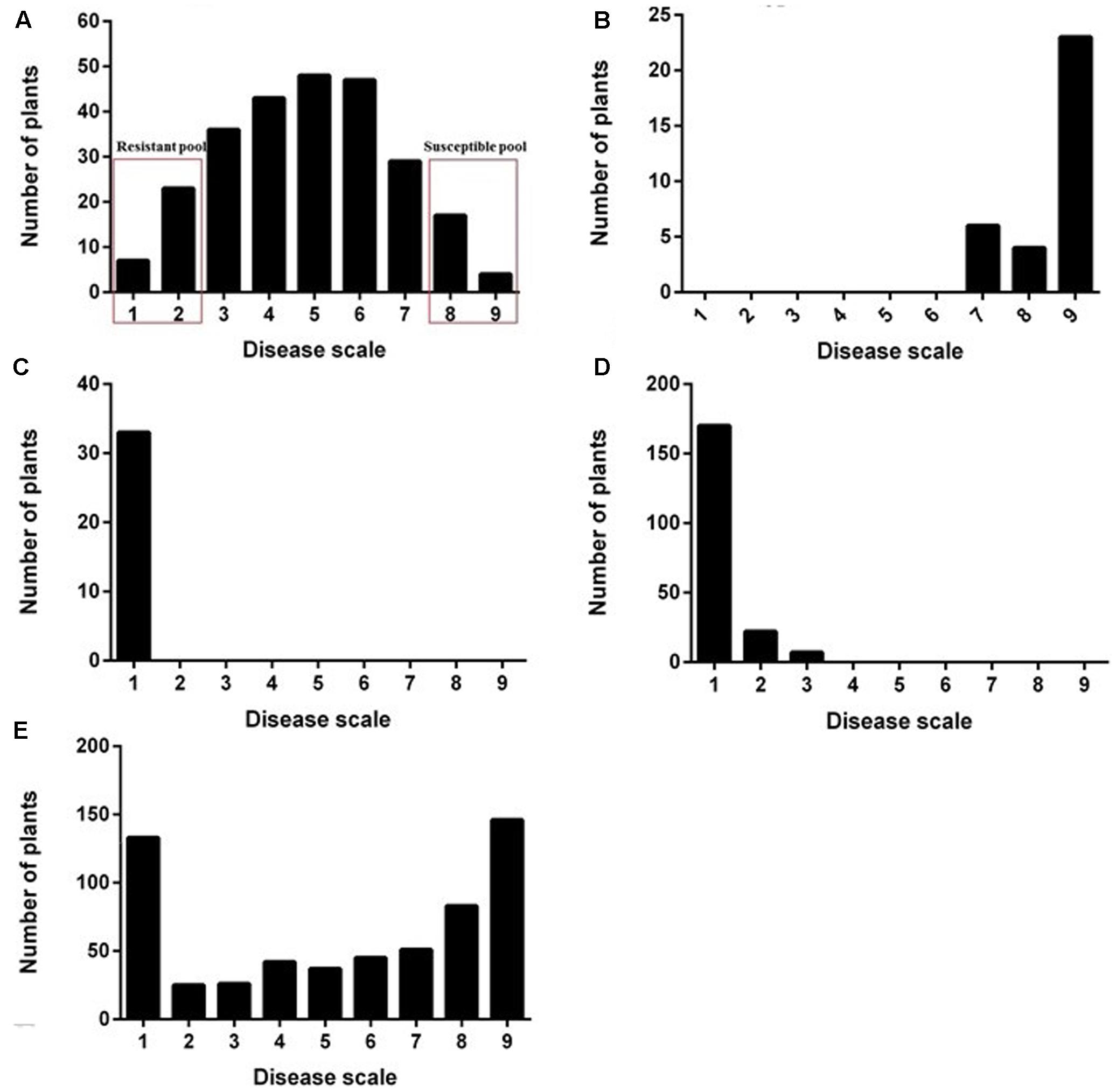
FIGURE 1. Distribution of disease severity for the two parental lines, F1 plants, F2 population, and BC1F1 population. The F2 population and the construction of R-pool and S-pool (A). Susceptible parental line “18327” (B). The resistant parental line “S72356” (C). The F1 plants (D). The BC1F1 population (E).
In this study, the parameters of SNP-index and Δ (SNP-index) (Abe et al., 2012; Takagi et al., 2013a) were calculated to identify candidate regions for maize stalk rot resistant QTLs. The reference sequence for SNP-index calculation was developed by replacing the detected SNPs from one of the parental cultivars with those from the reference genome. The SNP-index represents frequencies of parental alleles in the population of pooled individuals. Slide window analyses with parameters “2 Mb windows size and 100 kb increment” was applied to SNP-index plots.
The Δ (SNP-index) was calculated based on subtraction of SNP-index between R-pool and S-pool. SNP-index is equal to “0” or “1” when entire reads contain genomic fragments from P1 or P2, respectively. The Δ (SNP-index) value will be significantly different from 0 in genomic regions with major QTL of the target gene (Takagi et al., 2013a). We calculated statistical confidence intervals of Δ (SNP-index) for all the SNP positions with given read depths under the null hypothesis of no QTLs, and plotted them along with Δ (SNP-index). With a 95% confidence interval in 10,000 bootstrap replicates, the Δ (SNP-index) was obtained for each read depth.
Marker Development and QTL Analysis
To verify the major QTL for GSR resistance from QTL-seq, polymorphic markers were developed in the predicted region of maize chromosome 8. SSR markers in the predicted region were searched using the MISA tool2, and employed for polymorphism screening between two parental lines, and between the R-pool and S-pool. SNP markers that were in the predicted region of the QTL were converted to PCR-based markers, and the primers were designed using Primer 53. Polymorphic markers were used to screen the F2 population. The linkage analysis was performed using the software JoinMap 4.1 (Van Ooijen, 2006) and recombination values were converted to centiMorgan (cM) using the Kosambi mapping function (Kosambi, 1943). The genetic information together with phenotyping data was used for QTL analysis using the composite interval mapping (CIM) model in WinQTL cartographer 2.5 software (Wang et al., 2012).
Expression Analysis of the Candidate Genes for GSR Resistance
The expression of candidate genes was investigated using real-time quantitative PCR (qPCR). Leaf samples were collected from P1, P2, F1, F2-S (susceptible to GSR) and F2-R (resistant to GSR) individuals at the early stage of inoculated plants. Total RNA for all samples was extracted using Trizol Reagent (Invitrogen, Carlsbad, CA, United States) and digested with RNase-free DNase I (Takara Bio, Japan) for 30 min at 37°C. Reverse transcription was conducted by Super III Reverse Transcriptase (Invitrogen, San Diego, CA, United States). The qPCR primers for the candidate genes (Zm00001d011953 and Zm00001d011972) were 5′-CCAGCTGTACAGGAGCATGA-3′ (forward) and 5′-CCGGAACACGTCTTGGTAGT-3′ (reverse) for Zm00001d011953, 5′-AAAAGGCTTGTTGCTGGAGA-3′ (forward) and 5′-GGTGGAGGTGCATTTTGTCT-3′ for Zm00001d011972, respectively. qPCR was performed in a LightCycler® 96 Real-time PCR Instrument (Roche, Swiss) with SYBR Green Real-time PCR Master Mix (Takara, Japan). The gene expression levels were determined using Ct value normalized with the formula 2-ΔΔCt (Livak and Schmittgen, 2001). The maize Actin gene was employed as an endogenous control, with the following primers: 5′-GCCGGTTTCGCTGGTGATGATGCGCC-3′ (forward) and 5′-GTGATCTCCTTGCTCATACGATCGGC-3′. Three replicates were measured to calculate the average relative expression levels. A Student’s t-test was used to check the significant differences in expression levels among these five samples.
Results
Inheritance of GSR Resistance
Frequency distribution of resistance to GSR is presented in Figures 1A–E. Following artificial inoculation with F. graminearum, the inbred line “18327” (P1) plants showed severe stalk rot symptoms (Figure 1B); “S72356” (P2) exhibited complete resistance to GSR and no symptoms were observed (Figure 1C). Most of the F1 hybrids (85.3%) displayed high levels of resistance to GSR (Figure 1D), suggesting that the major GSR resistance allele might be dominant. The resistance to GSR in the F2 population showed continuous variation (Figure 1A), and a skewed distribution of disease severity was observed in BC1F1 population (Figure 1E). Based on these results, it was suggested that the resistance to GSR in P2 was likely to be a quantitatively inherited trait.
Sequencing and QTL-seq Mapping
Based on library construction and NGS-based high-throughput sequencing of P1, P2 and two DNA-pools, a total of 344 Gb of data was generated, including 2.93 billion of 150 bp high-quality clean reads, and 98.44–98.56% high-quality reads were mapped on the reference genome. The average sequence depths were 20-fold in parents and 30-fold in pools. The total number of variants was 16, 997, 640, including 15, 490, 449 SNPs and 1, 507, 191 indels. The Q20 ratio ranged from 95.66 to 96.21% (Table 1).
To identify the candidate genomic region conferring resistance to GSR, the SNP-index was calculated, based on each SNP identified. The average SNP-index was calculated with a sliding window of 2 Mb intervals with 100 kb increment for S-pool and R-pool to detect the candidate genomic regions. SNP-index graphs were generated for R-pool (Figure 2A) and S-pool (Figure 2B) by plotting the average SNP-index against the position of each sliding window in the P1 genome assembly. It was expected that the SNP-index graphs of the R-pool and S-pool would be identical for the genomic regions that are not relevant to phenotypic difference, whereas the genomic region harboring the GSR resistance QTL should exhibit unequal contribution from P1 and P2 parental genomes. In addition, the SNP-index of predicted regions for R-pool and S-pool would appear as mirror images (Takagi et al., 2013a). After calculating and combining the information of SNP-index in R-pool and S-pool, Δ (SNP-index) was calculated and plotted against the genome positions (Figure 2C).
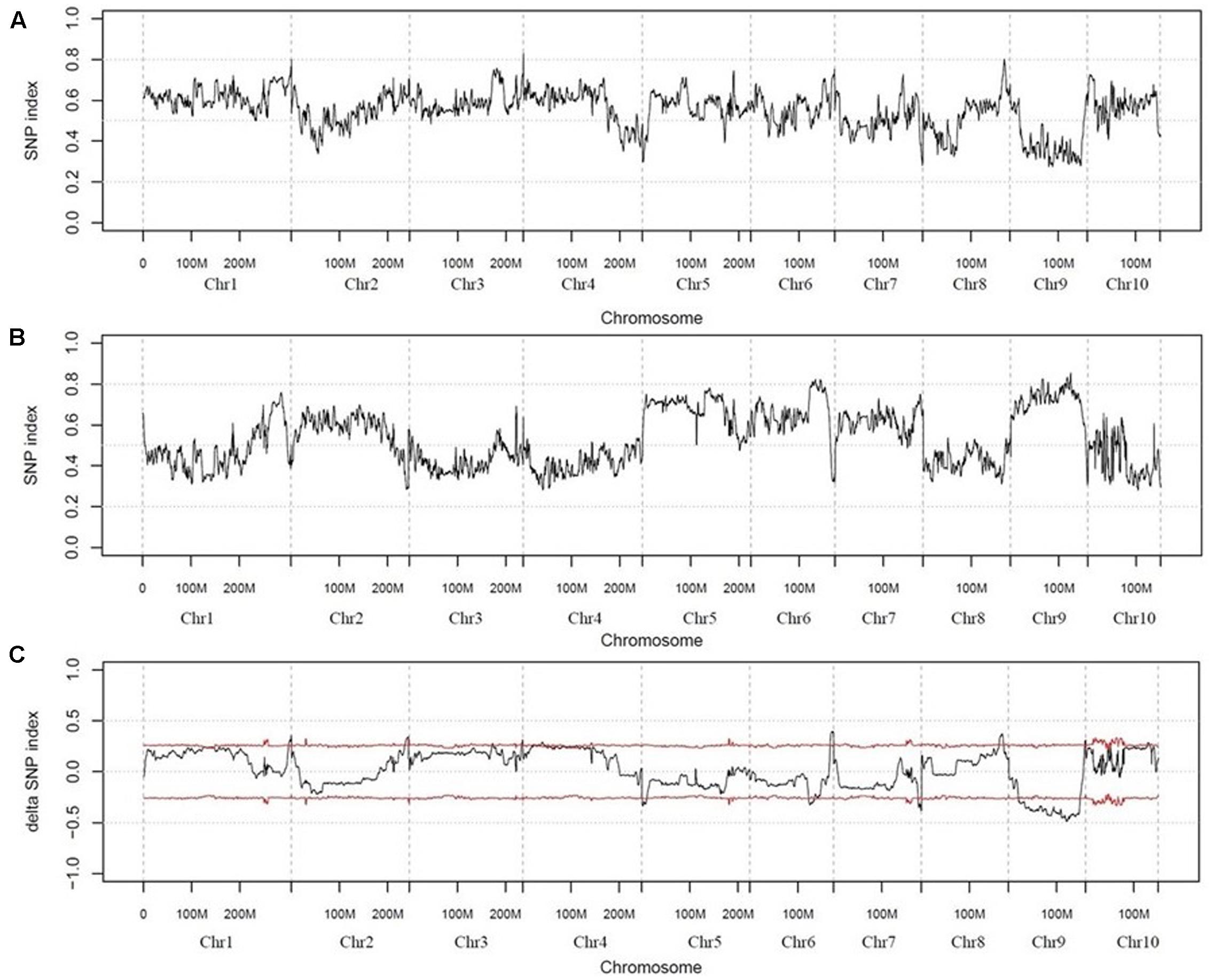
FIGURE 2. SNP-index graphs of R-pool (A), S-pool (B), and Δ (SNP-index) graph (C) from QTL-seq analysis. X-axis represents the position of 10 maize chromosome and Y-axis represents the SNP-index. A candidate QTL (Rgsr8.1) location was identified on maize chromosome 8 (161.004-170.535 Mb interval) with the criteria that the SNP-index in R-pool (A) was approximately 0.8, SNP-index in S-pool (B) was approximately 0.3, and the Δ (SNP-index) (C) was above the confidence value (P < 0.05).
In the present study, the region of chromosome 8 ranging from 161.001 to 170.6 Mb had an average SNP-index higher than 0.60 in R-pool with the highest equal to 0.80. Conversely, the average SNP-index in the region of S-pool was lower than 0.45 with the lowest equal to 0.3. The predicted genomic region harboring the resistance QTL to GSR identified by QTL-seq were determined by Δ (SNP-index) value. The threshold of the Δ (SNP-index) value was 0.25 at the 95% significance level. Results showed that the genomic region on the chromosome 8 from 161.001 to 170.6 Mb was significantly different from 0 (Figure 2C). These data demonstrated that in maize, a major QTL conferring GSR resistance was present in the 161.001–170.6 Mb region on chromosome 8. We named this region as Rgsr8.1.
Narrowing Down the Predicted Region by Polymorphism Markers
Based on 565 non-synonymous variations, a total of 45 SNP markers (Supplementary Table S1) were developed, which distributed equally over the predicted region according to physical position. A total of 729 SSR markers were searched from the predicted region. Among these SSR markers, 165 SSR markers (Supplementary Table S2), equally distributed on the predicted region, were used to analyze the polymorphism.
The 45 SNP markers and 165 SSR markers were checked for polymorphisms between P1 and P2, R-pool, and S-pool. Of the SNP markers, 33 markers amplified well, and 12 SNP markers were found polymorphic between P1 and P2, R-pool, and S-pool (Table 2). Twenty-nine SSR markers were identified to be polymorphic between P1 and P2, R-pool, and S-pool (Table 3). In total, 12 SNP markers and 29 SSR markers were used for QTL analysis based on the F2 populations. A major QTL for resistance to GSR, physically located in the region of 164.678–166.721 Mb on chromosome 8 (Figure 3), was flanked by two SNP markers (SNP-18 and SNP-25) with genetic distances of 4.57 and 6.62 cM. This result agreed with the QTL-seq analysis supporting a major GSR resistance QTL on chromosome 8. The LOD scores of the polymorphism markers within this region ranged from 0.26 to 45.23, and could explain 34.4% of the variance (Table 4). Additionally, we further narrowed down the Rgsr8.1 locus by using recombination test, based on 6 BC1F1 recombinants, which were recovered within the region on chromosome 8. To figure out the physical position where the recombinant events occurred, eight markers (Table 4) were used to analyze the P1, P2, and recombinants. The results showed that no recombinants were detected except for SSR-65 and SNP-25. Therefore, the mapping data narrowed the Rgsr8.1 locus down to a 2.04 Mb interval between the SSR-65 and SNP-25 (Figure 4). Furthermore, we used these eight markers to screen the F2 and BC1F1 population. We estimated that the SSR-78 marker was linked with GSR resistance in “S72356” via phenotypic and genotypic identification.
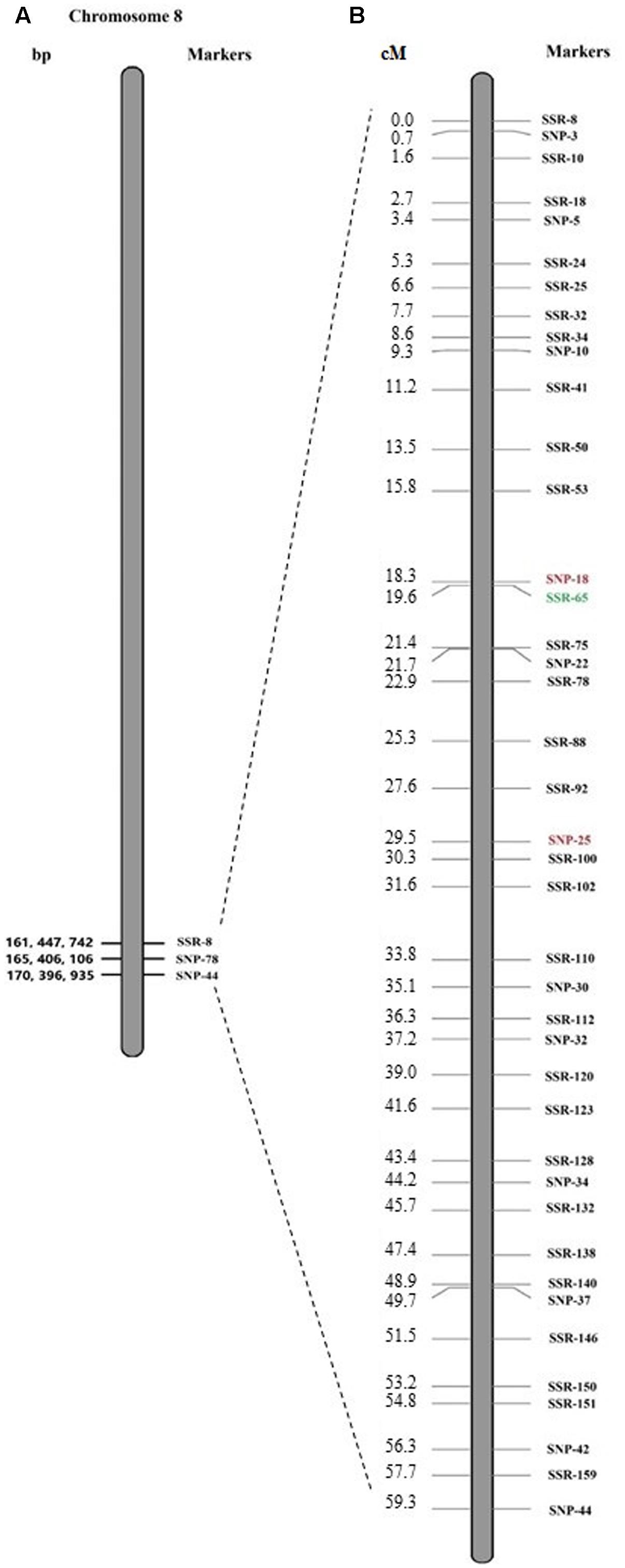
FIGURE 3. Integration of QTL-seq-predicted region on chromosome 8 (A) and traditional QTL mapping with SNP and SSR markers (B). The genetic (cM) or physical (bp) positions, and the markers mapped on the chromosome are specified on the left and right side, respectively. The markers identified by QTL mapping and recombination test are marked in red and green, respectively.
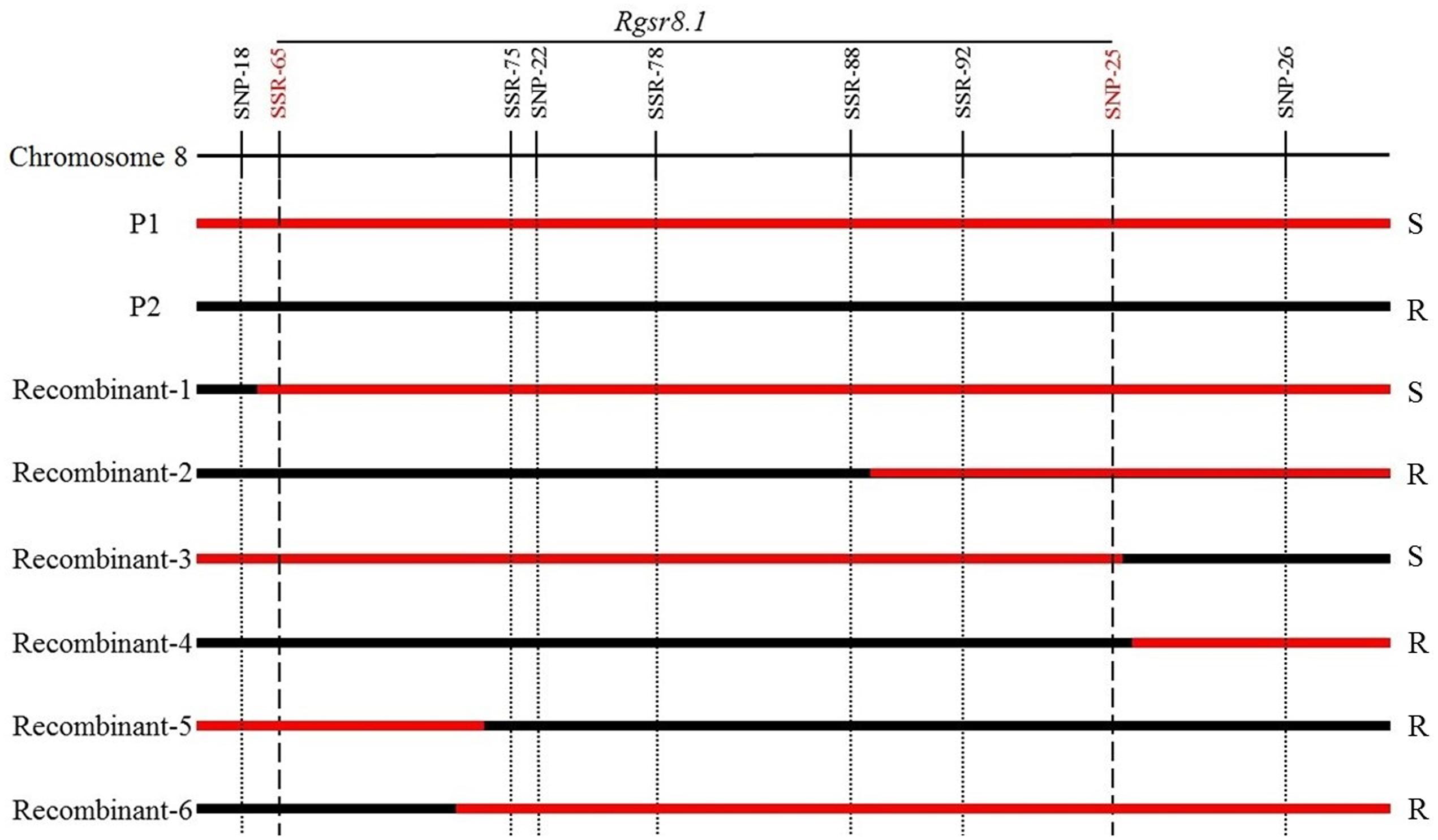
FIGURE 4. Examination of the recombinants in BC1F1 population using the polymorphism marker in Table 4. The red bar is the genome from 18327 (S). The black bar is the region from S72356 (R).
Candidate Genes for GSR Resistance
Based on the Maize reference genome (RefGen_V4, see text footnote 1), 33 genes were located in the predicted region (Supplementary Table S3). Based on gene annotation of the region, two genes, Zm00001d011953 (Zm953) and Zm00001d011972 (Zm972), were chosen as candidate genes. Zm953 encodes an auxin response factor, and Zm972 encodes a disease resistance protein. The physical location of Zm953 (164, 991, 768) and Zm972 (165, 428, 843) were near to SSR-78, which had the highest LOD value (Table 4).
In addition, the expression levels of Zm953 and Zm972 were investigated in two parental lines, the F1 plant, and the susceptible and resistant individuals in F2 by using qPCR. The results showed that the expression level of Zm953 in the resistant plants from P2, F1, and F2-R was significantly higher than that in the susceptible plants from P1 and F2-S (Figure 5). The expression level of Zm972 showed a similar result (Figure 5). Therefore, based on the gene annotation and results of expression analysis, we inferred that Zm953 and Zm972 may be the candidate genes for the major QTL conferring GSR resistance.
Discussion
Maize stalk rot is a major and serious disease that reduces grain yield and quality (Yang et al., 2002a). In the past, several studies indicated a single dominant gene related to GSR resistance (Chen and Song, 1999; Yang et al., 2002b, 2004). However, other studies reported that GSR resistance was unlikely to be controlled by a single dominant gene, but was more likely to be a quantitative trait (Pè et al., 1993; Yang et al., 2010; Zhang et al., 2012). In this study, the F2 and BC1F1 populations derived from the cross “18327 × S72356” were used to analyze the inheritance of GSR resistance. The results obtained indicated that the GSR resistance was a quantitatively inherited trait.
Previous work has identified QTLs linked to GSR resistance through RAPD, RFLP, and SSR markers, and mapped on the chromosome 1, 3, 4, 5, 6, and 10, respectively (Pè et al., 1993; Yang et al., 2004, 2010; Zhang et al., 2012). No GSR resistance QTLs have been localized on chromosome 8. However, some resistant QTLs to Gibberella ear rot have been mapped on chromosome 8. Robertson-Hoyt et al. (2006) found a resistant QTL to Gibberella ear rot in the locus bin 8.03, explaining 10.7% of variation. Ding et al. (2008) located one QTL to Gibberella ear rot on bin 8.05, which accounted for 7% of the variation. In the present study, we identified and mapped one major genomic region harboring a GSR resistant QTL on chromosome 8, ranging from 161.001 to 170.6 Mb (contained in bin 8.06–8.08). We achieved this by studying the F2 population via the QTL-seq approach (Takagi et al., 2013a), which took advantage of the high-throughput genome re-sequencing and BSA. We named this major QTL as Rgsr8.1, which is located near the QTL conferring resistance to Gibberella ear rot detected by Ding et al. (2008). The result indicated that these two QTLs, Rgsr8.1 (bin 8.06–8.08) and the QTL (bin 8.05) reported by Ding et al. (2008) were located on different regions of chromosome 8. Therefore, though these two QTLs are nearby, they are different loci. Rgsr8.1 is a new GSR resistance QTL on chromosome 8.
Furthermore, based on the traditional QTL analysis using F2 and recombination test using BC1F1, we narrowed down the physical location of the resistance QTL Rgsr8.1 to a 2.04-Mb interval on chromosome 8 that contributed 34.4% of the phenotype variation. As shown in Supplementary Table S3, 33 genes were located in this 2.04 Mb region. Among these genes, Zm00001d011953 (Zm953) and Zm00001d011972 (Zm972) were noteworthy based on the gene annotation of maize. The description of Zm953 indicated that it is an auxin response factor, a transcription factor that binds specifically to the DNA sequence 5′-TGTCTC-3′ found in the auxin-responsive promoter elements. The annotation of Zm972 is putative disease resistance protein RPP13-like protein. Recently, a transcriptome analysis of maize resistance to F. graminearum has been discussed (Liu et al., 2016), which posited that the GSR resistance is conferred by two QTLs, qRfg1 (Yang et al., 2010) and qRfg2 (Zhang et al., 2012). The results of the transcriptome analysis of GSR resistance indicated that qRfg1 enhances GSR resistance through both constitutive and induced high expression of defense-related genes, and qRfg2 confers the GSR resistance via relatively lower induction of auxin signaling (Liu et al., 2016). In addition, the physical position of Zm953 and Zm972 are 164, 991, 768 and 165, 428, 843 on chromosome 8. Thus, both are closed to the SSR-78 marker, which has the highest LOD value (Table 4). The expression analysis indicated that the expression levels of Zm953 and Zm972 in resistant plants were higher than in the susceptible plants (Figure 5). Therefore, we hypothesize that Zm953 and Zm972 are possible candidate genes for Rgsr8.1, and further experiments need to be done to further these observations.
Generally, the classical phenotypic selection of resistance to GSR is labor-intensive, time-consuming, and can be confounded by environmental factors. However, marker-assisted selection of disease resistance can be effectively deployed in crop breeding (Boyd et al., 2013). In this study, we developed an SSR marker (SSR-78) located at 165, 243, 672 on chromosome 8, and showed that it is tightly linked with the resistance genotype. Although the validation of SSR-78 has been verified using F2 and BC1F1 populations, more experiments are needed to confirm the results. Resistance plants could be selected at an early generation using the SSR-78 marker. The present results will be useful in maize breeding programs aimed at improving GSR resistance.
Author Contributions
QC, JS, W-PD, and G-RY designed research. QC, YJ, JZ, and X-LX performed research. All authors analyzed the data. QC, L-YX, and G-RY wrote the paper.
Funding
This work was financially supported by funding from Applied Basic Research Programs of Science and Technology Department in Sichuan, China (2015JY0019), the Project of Innovation Ability Improvement in Sichuan, China (2015JSCX-004).
Conflict of Interest Statement
The authors declare that the research was conducted in the absence of any commercial or financial relationships that could be construed as a potential conflict of interest.
Supplementary Material
The Supplementary Material for this article can be found online at: http://journal.frontiersin.org/article/10.3389/fpls.2017.01355/full#supplementary-material
Footnotes
References
Abe, A., Kosugi, S., Yoshida, K., Natsume, S., Takagi, H., Kanzaki, H., et al. (2012). Genome sequencing reveals agronomically important loci in rice using MutMap. Nat. Biotech. 30, 174–178. doi: 10.1038/nbt.2095
Ahmad, Y., Hameed, A., and Aslam, M. (1996). Effect of soil solarization on corn stalk rot. Plant Soil 179, 17–24. doi: 10.1007/bf00011638
Boyd, L. A., Ridout, C., O’Sullivan, D. M., Leach, J. E., and Leung, H. (2013). Plant-pathogen interactions: disease resistance in modern agriculture. Trends Genet. 29, 233–240. doi: 10.1016/j.tig.2012.10.011
Chambers, K. R. (1988). Effect of time of inoculation on Diplodia stalk and ear rot of maize in South Africa. Plant Dis. 72, 529–531. doi: 10.1094/PD-72-0529
Chen, S. J., and Song, T. M. (1999). Disease resistance of maize stalk rot. Simple genetics controlled by a single gene. Acta. China Agric. Univ. 4:56.
Chen, W., Yao, J., Chu, L., Yuan, Z., Li, Y., and Zhang, Y. (2015). Genetic mapping of the nulliplex-branch gene (gb_nb1) in cotton using next-generation sequencing. Theor. Appl. Genet. 128, 539–547. doi: 10.1007/s00122-014-2452-2
Cook, R. J. (2008). The incidence of stalk rot (Fusarium spp.) on maize hybrids and its effect on yield of maize in Britain. Ann. Appl. Biol. 88, 23–30. doi: 10.1111/j.1744-7348.1978.tb00674.x
Das, S., Upadhyaya, H. D., Bajaj, D., Kujur, A., Badoni, S., Laxmi, et al. (2015). Deploying QTL-seq for rapid delineation of a potential candidate gene underlying major trait-associated QTL in chickpea. DNA Res. 22, 193–203. doi: 10.1093/dnares/dsv004
Ding, J. Q., Wang, X. M., Chander, S., Yan, J.-B., and Li, J.-S. (2008). QTL mapping of resistance to Fusarium ear rot using a RIL population in maize. Mol. Breed. 22, 395–403. doi: 10.1007/s11032-008-9184-4
Dorn, B., Forrer, H.-R., Schürch, S., and Vogelgsang, S. (2009). Fusarium species complex on maize in Switzerland: occurrence, prevalence, impact and mycotoxins in commercial hybrids under natural infection. Eur. J. Plant Pathol. 125, 51–61. doi: 10.1007/s10658-009-9457-8
Fekih, R., Takagi, H., Tamiru, M., Abe, A., Natsume, S., Yaegashi, H., et al. (2013). MutMap+: genetic mapping and mutant identification without crossing in rice. PLoS ONE 8:e68529. doi: 10.1371/journal.pone.0068529
Foiada, F., Westermeier, P., Kessel, B., Ouzunova, M., Wimmer, V., Mayerhofer, W., et al. (2015). Improving resistance to the European corn borer: a comprehensive study in elite maize using QTL mapping and genome-wide prediction. Theor. Appl. Genet. 128, 875–891. doi: 10.1007/s00122-015-2477-1
Francis, R., and Burgess, L. (1975). Surveys of Fusaria and other fungi associated with stalk rot of maize in Eastern Australia. Crop Pasture Sci. 26, 801–807. doi: 10.1071/AR9750801
Frey, T. (2005). Fine-Mapping, Cloning, Verification, and Fitness Evaluation of a QTL, Rcg1, Which Confers Resistance to Colletotrichum graminicola in Maize. Ph.D. thesis, University of Delaware, Newark, DE.
Giovannoni, J. J., Wing, R. A., Ganal, M. W., and Tanksley, S. D. (1991). Isolation of molecular markers from specific chromosomal intervals using DNA pools from existing mapping populations. Nucleic Acids Res. 19, 6553–6558. doi: 10.1093/nar/19.23.6553
Jung, M., Weldekidan, T., Schaff, D., Paterson, A., Tingey, S., and Hawk, J. (1994). Generation-means analysis and quantitative trait locus mapping of anthracnose stalk rot genes in maize. Theor. Appl. Genet. 89, 413–418. doi: 10.1007/bf00225375
Kosambi, D. D. (1943). The estimation of map distances from recombination values. Ann. Hum. Genet. 12, 172–175. doi: 10.1111/j.1469-1809.1943.tb02321.x
Ku, L., Ren, Z., Chen, X., Shi, Y., Qi, J., Su, H., et al. (2016). Genetic analysis of leaf morphology underlying the plant density response by QTL mapping in maize (Zea mays L.). Mol. Breed. 36:63. doi: 10.1007/s11032-016-0483-x
Lal, S., and Singh, I. S. (1984). Breeding for resistance to downy mildews and stalk rots in maize. Theor. Appl. Genet. 69, 111–119. doi: 10.1007/BF00272879
Ledencan, T., Simic, D., Brkic, I., Jambrovic, A., and Zdunic, Z. (2003). Resistance of maize inbreds and their hybrids to Fusarium stalk rot. Czech J. Genet. Plant 39, 15–20.
Li, H., and Durbin, R. (2009). Fast and accurate short read alignment with Burrows–Wheeler transform. Bioinformatics 25, 1754–1760. doi: 10.1093/bioinformatics/btp324
Li, W. H., Xu, X. D., Li, G., Guo, L. Q., Wu, S. W., Jiang, Y., et al. (2012). Characterization and molecular mapping of RsrR, a resistant gene to maize head smut. Euphytica 187, 303–311. doi: 10.1007/s10681-012-0747-4
Liu, Y., Guo, Y., Ma, C., Zhang, D., Wang, C., and Yang, Q. (2016). Transcriptome analysis of maize resistance to Fusarium graminearum. BMC Genomics 17:477. doi: 10.1186/s12864-016-2780-5
Livak, K. J., and Schmittgen, T. D. (2001). Analysis of relative gene expression data using real-time quantitative PCR and the 2-ΔΔCT method. Methods 25, 402–408. doi: 10.1006/meth.2001.1262
Michelmore, R. W., Paran, I., and Kesseli, R. V. (1991). Identification of markers linked to disease-resistance genes by bulked segregant analysis: a rapid method to detect markers in specific genomic regions by using segregating populations. Proc. Natl. Acad. Sci. U.S.A. 88, 9828–9832. doi: 10.1073/pnas.88.21.9828
Nair, S. K., Babu, R., Magorokosho, C., Mahuku, G., Semagn, K., Beyene, Y., et al. (2015). Fine mapping of Msv1, a major QTL for resistance to Maize Streak Virus leads to development of production markers for breeding pipelines. Theor. Appl. Genet. 128, 1839–1854. doi: 10.1007/s00122-015-2551-8
Parry, D. W., Jenkinson, P., and McLeod, L. (1995). Fusarium ear blight (scab) in small grain cereals—a review. Plant Pathol. 44, 207–238. doi: 10.1111/j.1365-3059.1995.tb02773.x
Pè, E. M., Gianfranceschi, L., Taramino, G., Tarchini, R., Angelini, P., Dani, M., et al. (1993). Mapping quantitative trait loci (QTLs) for resistance to Gibberella zeae infection in maize. Mol. General Genet. 241, 11–16. doi: 10.1007/bf00280195
Robertson-Hoyt, L. A., Jines, M. P., Balint-Kurti, P. J., Kleinschmidt, C. E., White, D. G., Payne, G. A., et al. (2006). QTL mapping for Fusarium ear rot and fumonisin contamination resistance in two maize populations. Crop Sci. 46, 1734–1743. doi: 10.2135/cropsci2005.12-0450
Salvi, S., and Tuberosa, R. (2005). To clone or not to clone plant QTLs: present and future challenges. Trends Plant Sci. 10, 297–304. doi: 10.1016/j.tplants.2005.04.008
Takagi, H., Abe, A., Yoshida, K., Kosugi, S., Natsume, S., Mitsuoka, C., et al. (2013a). QTL-seq: rapid mapping of quantitative trait loci in rice by whole genome resequencing of DNA from two bulked populations. Plant J. 74, 174–183. doi: 10.1111/tpj.12105
Takagi, H., Tamiru, M., Abe, A., Yoshida, K., Uemura, A., Yaegashi, H., et al. (2015). MutMap accelerates breeding of a salt-tolerant rice cultivar. Nat. Biotech. 33, 445–449. doi: 10.1038/nbt.3188
Takagi, H., Uemura, A., Yaegashi, H., Tamiru, M., Abe, A., Mitsuoka, C., et al. (2013b). MutMap-Gap: whole-genome resequencing of mutant F2 progeny bulk combined with de novo assembly of gap regions identifies the rice blast resistance gene Pii. New Phytol. 200, 276–283. doi: 10.1111/nph.12369
Trick, M., Adamski, N. M., Mugford, S. G., Jiang, C.-C., Febrer, M., and Uauy, C. (2012). Combining SNP discovery from next-generation sequencing data with bulked segregant analysis (BSA) to fine-map genes in polyploid wheat. BMC Plant Biol. 12:14. doi: 10.1186/1471-2229-12-14
Van Ooijen, J. (2006). JoinMap 4, Software for the Calculation of Genetic Linkage Maps in Experimental Populations. Wageningen: Kyazma BV.
Wang, K., Li, M., and Hakonarson, H. (2010). ANNOVAR: functional annotation of genetic variants from high-throughput sequencing data. Nucleic Acids Res. 38:e164. doi: 10.1093/nar/gkq603
Wang, S., Basten, C., and Zeng, Z. (2012). Windows QTL Cartographer v2.5. Raleigh, NC: North Carolina State University.
Wu, H., Sun, S., Fan, Z., Liu, C., Yang, T., and Zhu, J. (2007). Research condition and prevention countermeasures of maize stalk rot. J. Mazie Sci. 129–132.
Xia, C., Chen, L.-L., Rong, T.-Z., Li, R., Xiang, Y., Wang, P., et al. (2015). Identification of a new maize inflorescence meristem mutant and association analysis using SLAF-seq method. Euphytica 202, 35–44. doi: 10.1007/s10681-014-1202-5
Yang, D. E., Jin, D. M., Wang, B., Zhang, D. S., Nguyen, H. T., Zhang, C. L., et al. (2005). Characterization and mapping of Rpi1, a gene that confers dominant resistance to stalk rot in maize. Mol. Genet. Genomics 274, 229–234. doi: 10.1007/s00438-005-0016-5
Yang, D. E., Zhang, C. L., and Wang, Y. G. (2002a). Review of maize stalk rot in China. J. Maize Sci. 1, 4–6.
Yang, D. E., Zhang, C. L., and Wang, G. Y. (2002b). Study on the Rfg1 (resistance to Fusarium graminearum Schw) in maize. Acta Agron. Sin. 29, 129–133.
Yang, D. E., Zhang, C. L., Zhang, D. S., Jin, D. M., Weng, M. L., Chen, S. J., et al. (2004). Genetic analysis and molecular mapping of maize (Zea mays L.) stalk rot resistant gene Rfg1. Theor. Appl. Genet. 108, 706–711. doi: 10.1007/s00122-003-1466-y
Yang, Q., Yin, G., Guo, Y., Zhang, D., Chen, S., and Xu, M. (2010). A major QTL for resistance to Gibberella stalk rot in maize. Theor. Appl. Genet. 121, 673–687. doi: 10.1007/s00122-010-1339-0
Zhang, D., Liu, Y., Guo, Y., Yang, Q., Ye, J., Chen, S., et al. (2012). Fine-mapping of qRfg2, a QTL for resistance to Gibberella stalk rot in maize. Theor. Appl. Genet. 124, 585–596. doi: 10.1007/s00122-011-1731-4
Keywords: maize stalk rot, next-generation sequence, QTL-seq, finely map, resistance QTL, Gibberella, candidate gene
Citation: Chen Q, Song J, Du W-P, Xu L-Y, Jiang Y, Zhang J, Xiang X -L and Yu G-R (2017) Identification, Mapping, and Molecular Marker Development for Rgsr8.1: A New Quantitative Trait Locus Conferring Resistance to Gibberella Stalk Rot in Maize (Zea mays L.). Front. Plant Sci. 8:1355. doi: 10.3389/fpls.2017.01355
Received: 12 April 2017; Accepted: 20 July 2017;
Published: 03 August 2017.
Edited by:
Anna Maria Mastrangelo, Centro di Ricerca per l’Orticoltura (CRA), ItalyReviewed by:
Toi J. Tsilo, Agricultural Research Council of South Africa (ARC-SA), South AfricaLiezhao Liu, Southwest University, China
Copyright © 2017 Chen, Song, Du, Xu, Jiang, Zhang, Xiang and Yu. This is an open-access article distributed under the terms of the Creative Commons Attribution License (CC BY). The use, distribution or reproduction in other forums is permitted, provided the original author(s) or licensor are credited and that the original publication in this journal is cited, in accordance with accepted academic practice. No use, distribution or reproduction is permitted which does not comply with these terms.
*Correspondence: Gui-Rong Yu, Z3Vpcm9uZ3l1QHllYWgubmV0
 Qian Chen
Qian Chen Jun Song
Jun Song Wen-Ping Du
Wen-Ping Du Li-Yuan Xu
Li-Yuan Xu Yun Jiang
Yun Jiang Jie Zhang
Jie Zhang Xiao-Li Xiang
Xiao-Li Xiang Gui-Rong Yu
Gui-Rong Yu

